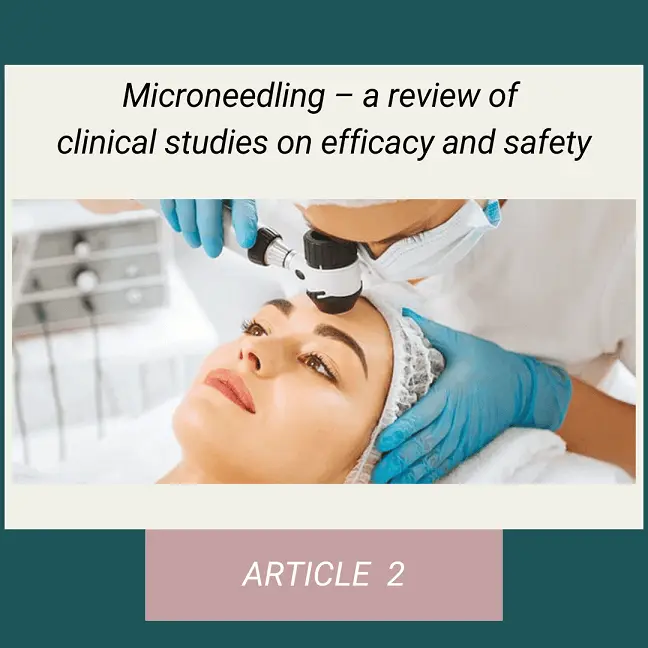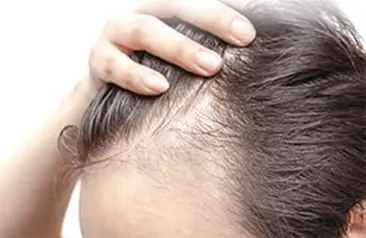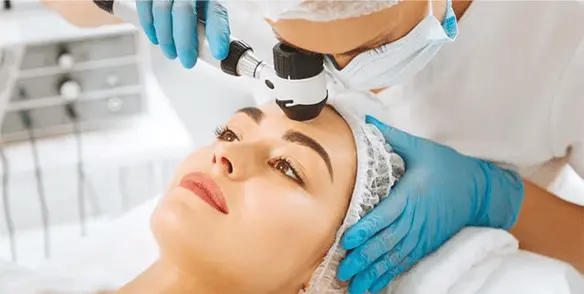Microneedling – a review of clinical studies on efficacy and safety

The topic of various options for transdermal administration of drugs and cosmetic preparations has now become very popular. Here is a review conducted by Korean researchers in order to systematize, summarize and analyze the current data on the clinical efficacy and safety of micro-needling.
С. S.-Y. Jeong, Y.-S. Lee, S.-Y. Kim Department of Anatomy and Acupuncture, College of Korean Medicine, Gajong University, Seongnam, Republic of Korea;
Ч. J.-H. Park, 2 Department of Bionanotechnology, Gachon Institute of Bionan Research, Gachon University, Seongnam, Republic of Korea;
Ч. J.-Y. Park, College of Korean Medicine, Daejeon University, Daejeon, Republic of Korea
Introduction

Micro-needles (MI) are medical instruments consisting of one or more needles of a few microns in length, providing effective introduction of therapeutic drugs into the upper layers of the skin . Needle lengths can range from 25 to 1000 microns – long enough to penetrate the stratum corneum and reach the dermis. Such short needle lengths reduce the likelihood of vasovagal reactions (fainting), as well as stress or anxiety in patients who are afraid of needles, and reduce pain that occurs with a regular needle. MIs are made of different materials, such as silicone, metal, or glass. Their shape can range from cones to pyramids with a square base, depending on the manufacturing method.
Micro-needles can be divided into five main types: solid, coated, biosoluble, hollow and hydrogel-forming, depending on the desired method of drug delivery.
Solid micro-needles are used to form temporary microchannels in the stratum corneum of the skin, thus increasing the absorption of various medications, including those included in creams, gels, solutions and transdermal patches. Coated micro-needles allow a therapeutic composition to be applied to the needle itself so that it is absorbed by the skin after injection.
Biosoluble micro-needles contain a drug that gradually dissolves and is released upon contact with interstitial fluid after the needles are inserted into the skin.
Hollow micro-needles allow delivery of the drug into the skin through a hollow needle. They can be used to inject the compound continuously by applying pressure to the channels already formed or by electrophoresis.
Finally, hydrogel-forming micro-needles do not contain drugs inside, similar to coated or dissolving MI. They attach to the skin by forming a small tubercle around the tip of the needle. The substance contained in the reservoir of the needle is gradually introduced into the patient’s body due to microcirculation in the skin.
In clinical practice micro needles are used as part of the following systems: mesorollers (microneedle therapy systems, MTS), fractionated radiofrequency needles (microneedle radiofrequency, MRF), hollow MI and micro needle applicators (microneedle array patches, MAP).
Mesorollers are rollers or stamps covered with micro-needles; there is also an improved version – automatic mesorollers (AMTS). They are mainly used for medical and cosmetic skin procedures, for example, for correction of postacne scars, striae and wrinkles. Their action is based on stimulation of the processes of neoangiogenesis and neocollagenesis due to mechanical stimulation of the natural wound healing reaction.
MRF is a device combining the action of MTS micro-needles and fractional radiofrequency action. Thanks to this, thermal energy directly affects the dermis, minimally affecting the surrounding tissues. This method is used for skin rejuvenation, facial lifting and treatment of armpit hyperhidrosis.
Mesorollers and fractionated radiofrequency needles are mainly used locally in the skin, while hollow micro-needles are considered a tool for systemic drug delivery. Hollow MIs are used as an alternative to conventional needles in vaccination and for insulin administration in diabetes.
Finally, microneedle applicators – IDAs combine the action of transdermal patches and the ability to administer various substances using microneedles, which gives advantages in convenience and safety. IDA usually consist of coated micro-needles or biosoluble MI. Recently, experience has been described with coated IDAs in clinical trials of glucagon delivery for correction of hypoglycemia, thyroid hormone for treatment of osteoporosis, and zolmitriptan for migraine. In addition, biosoluble IDA has been used in studies of influenza vaccination and prolactin-inhibitory hormone administration.
More and more studies are related to the clinical application of micro-needles. Recently, a number of cases of their effective use for the correction of scars and wrinkles have been described. In addition, a number of descriptive reviews have been published showing that MIs provide effective drug administration, including vaccines, insulin, and protein drugs. However, there are few systematic reviews analyzing the clinical value of micro-needles beyond a specific type of administration or diagnosis. The purpose of this study is to summarize and analyze the currently available data, including the clinical use and safety of microneedles, and to assess the feasibility of their future use.
Results
Based on primary criteria in the form of title, abstract, and full text, 5624 studies out of 6166 were selected from the database, after 542 replications were excluded. Of these, the first stage excluded were non-MI-related papers (n = 4388); papers related to MI but not to therapeutic use (n = 643); and nonclinical studies (n = 496). Of the remaining articles, those that were not written in English or Korean (n = 3), did not analyze the effectiveness of micro-needles (i.e., MI was used as an adjunctive method) (n = 4), or were not related to controlled trials (n = 52) were excluded.
As a result, 38 studies (31 randomized controlled trials and 7 comparative clinical trials) meeting our criteria were selected for review. Of these, 19 had a crossover design, where one patient received two treatments consecutively or the patient received two treatments simultaneously on different parts of the body. In all studies with a cross-sectional design, our analysis covered only the first session. The mean sample size of the randomized controlled trials (RCTs) included in the review was 165.7 ± 319.7 and that of the clinical controlled trials (CCTs) was 18.8 ± 7.8.
Twelve studies were conducted in the United States and Korea; three in Israel; two in China; one each in Australia, Bangladesh, Belgium, Egypt, France, Germany, Iran, Japan, and Switzerland. In the present review, hollow micro-needles (n = 13) were the most frequently encountered discussions, followed by MAP micro-needle applicators (n = 11), MTS mesorollers (n = 8), and MRF fractionated radiofrequency needles (n = 6). We divided the diseases mentioned in the studies into the following four categories: (1) skin diseases and skin care (n = 19; 50.0%); (2) vaccine administration (n = 11; 28.9%); (3) insulin administration to diabetic patients (n = 5; 13.2%); (4) other (n = 3; 7.9%, two cases of osteoporosis and one of migraine). The data show that MTS (n = 8; 88.9%), MRF (n = 6; 100%), and MAP (n = 5; 45.5%) were most commonly used in the treatment of skin diseases, and hollow MI (n = 8; 72.7%) were most commonly used for vaccination.
Effectiveness

Skin diseases, skin care
The skin diseases and skin care section included studies on the correction of scars, wrinkles, and skin improvement (n = 4 respectively, 21.1%); alopecia, acne, and warts (n = 1 respectively, 5.3%). MTS (n = 8), MRF (n = 6), and MAP (n = 5) were used for drug delivery in these cases.
Scars
In the correction of scars, each study compared the effectiveness of MTS or MRF and laser therapy (CO2 laser or fractionated laser with erbium glass) with the control (no treatment). Mesorollers were shown to treat scars better than the CO2 laser, as evaluated by both physicians and patients. However, other studies have not reported results comparing between groups when evaluating treatment efficacy.
Facial wrinkles
In each of the relevant studies, MRF or IDA were applied topically to correct facial wrinkles, including wrinkles around the eyes and/or nasolabial folds. The data from these studies showed no clear superiority of MRF over neuroprotein type A injections or classic intradermal injections. The results of wrinkle correction procedures varied at different stages according to different efficacy criteria. For example, the results of wrinkle correction using IDA and the placebo patch did not differ after both four and eight weeks, but at the end of the treatment period (12 weeks), significant differences were found between the groups. In a study where a wrinkle cream was used in a control group, the data indicated that IDA together with the wrinkle cream worked better than the cream alone.
Skin Care.
In a placebo-controlled study of facial hyperpigmentation correction, the effectiveness of micro-needle applicators was proven for several phases of the study. IDAs were found to lighten the skin and regulate melanin levels better than the use of a bleaching cream. The two studies on mesorollers only provide data comparing skin conditions before and after the study, but not between the two groups.
Alopecia.
Two alopecia therapy studies noted that the additional use of micro-needles (MTS or AMTS) provided more effective delivery of the therapeutic agents. When automatic mesorollers were added to the minoxidil treatment regimen, there were positive results with a more pronounced increase in hair density compared to minoxidil treatment alone.
Actinic Keratosis
In actinic keratoses, the use of mesorollers with aminolevulinic acid showed a positive effect on skin moisture and transepidermal fluid loss scores compared to a roller without the drug. In another study, the combination of MTS with aminolevulinic acid administration reduced actinic keratosis symptoms as assessed by the patient compared with the use of aminolevulinic acid alone, but there was no difference between the groups as assessed by the physician.
Other skin-related studies
Other studies have focused on the elements of postacne and hyperhidrosis. The use of fractionated radiofrequency needles compared to placebo has been shown to reduce the severity of hyperhidrosis on the disease severity scale and the visual analog sweating scale. In contrast, no statistically significant difference was found in the postacne study and no statistical comparison was made between the results of micro-needle and CO2 laser treatment.
Safety
Side effects
Of the studies selected for review, three had no information on side effects, and two said that none of the groups had any. Thirty-two studies reported side effects, and in all cases of MTS and MRF (n = 12) they were grade 1 (mild) and went away during the follow-up period. Two IDA studies reported grade 2 side effects that required local or non-invasive intervention. All of these side effects also went away during the follow-up period. Two studies of hollow MI reported grade 3 side effects and one reported grade 5 side effects.
Pain caused by micro-needles
Pain due to MI was reported in 18 studies (MTS, n = 3; MRF, n = 3; MAP, n = 3; hollow MI, n = 9). Pain intensity was assessed using a visual analog scale in 14 studies. One study group asked patients to complete a questionnaire with response options ranging from 1 (poor experience) to 5 (excellent experience). The MTS studies (n = 3) found that mesorollers caused more pain than placebo rollers. The other two studies noted that only patients in the treatment group experienced pain; there was no such sensation in the control group. Of the three studies reporting pain after MRF application, one did not report pain in the control group (CO2 laser), and two reported it in the control group (CO2 laser, botulinum neuroprotein), but there were no statistically significant differences between the control and treatment groups.
The use of micro-needle applicators corresponded to a statistically lower (on a visual analog scale) level of pain compared to cryotherapy. Pain caused by IDA was significantly lower than in the control group. Nine studies were conducted using hollow micro-needles to assess pain levels. Six of them separately evaluated pain when the MI was punctured and when the drug was infused. Of the six studies, five stated that the hollow micro-needles caused much less pain when punctured but more pain when infused than classic intradermal, subcutaneous and intramuscular injections. One study notes that puncture and infusion pain were greater than subcutaneous injections. In three other studies, hollow MI caused much more pain than subcutaneous or intramuscular injections, but less than intramuscular and intradermal injections, although no statistical comparison is given.

Discussion
We analysed 31 randomized controlled and 7 comparative clinical trials. When it comes to studies related to skin diseases or osteoporosis, drug delivery via MI was more effective than traditional administration and compared to placebo. Overall, the effectiveness of MI, according to our study, was higher than that of traditional instruments. However, many indicators were not adequately compared between the groups, so further studies will be needed to reach a definitive conclusion.
An important feature of this review compared with earlier contributions is that the data on microneedling were evaluated based on clinical studies, with an emphasis on assessing the therapeutic efficacy of MI.
It is noted that MI is used to treat a wide variety of nosological units. In skin-related studies, they have been used for the correction of scars and wrinkles, as well as for cosmetic skin care. In each of the 19 studies we reviewed, the MI provided a better effect than the control group. The only exception was the Lu study on the correction of wrinkles, where intradermal injections produced a better effect than MI in the clinical evaluation of the effectiveness of periorbital wrinkle correction. However, it should be noted that in many cases the results are given without quantitative comparison between the groups, and it turned out to be difficult to take them into account, since different control methods were used for each individual disease.
Compared to traditional procedures, microneedling has advantages such as the lack of the need for special training, cost-effectiveness, and convenience for people who are afraid of needles.
The majority of studies addressed the safety of MI (84.2%). Two studies reported no side effects, and three reported serious side effects of grade 3 or higher. Among the Grade 1 – 2 side effects that occurred in the MI group, redness, apparently related to skin irritation by the needles, was the most frequently reported. All side effects went away on their own during the follow-up period. These results indicate that although MI is a fairly safe treatment, skin irritation may still result in minor side effects. There is a clear need to develop future MI variants that cause fewer adverse reactions, as well as to inform patients about the possibility of such reactions.
The choice of the specific type of micro-needle depends on the disease and the purpose of the procedure. Fractional radiofrequency needles and mesorollers are used to correct scars and wrinkles by forming dermal collagen and stimulating remodeling processes. Most studies on local drug administration with mesoroller pretreatment and then drug application, as well as just local drug application, used micro-needle applicators or hollow micro-needles.
In general, the market for the application of micro-needles is quite homogeneous. For the correction of wrinkles, postacne elements as well as hyperpigmentation, cosmetic products are created where micro-needle applicators or roller-type micro-needles are used. The RCTs and RCTs covered in this review also addressed scarring, wrinkles, or hyperpigmentation. MI devices that inject drugs through microchannels formed with them are mainly used in cosmetology or for local skin stimulation, because very little drug is delivered in this way. Many products using this type of micro-needles are already on sale. When it comes to devices with MI used in pharmaceutical or medical applications, however, they require more stringent requirements and different factors to be considered than in the beauty industry.
This review confirms that development and research related to the use of micro-needles face several challenges. First of all, compared to the rapidly growing MI industry, clinical research on micro-needles as a medical device has been rather slow, since research on each device requires separate approval. Second, advances in the industry have not always been reflected in clinical trials.
On the technical side of the MI industry, there are many reports on the need for applied clinical research for a number of technologies. Among them are material application technology, drug dose control using magnetic wireless devices, drug application on MI using 3D printing, feedback system for the method of setting, timing and control of quantitative MI administration. There is a need for improvements in the technical aspects of development and production, including the introduction of a method for controlling the exact dose of the injected drug. There is also a need for increased attention to issues such as the proper use of MI. Compliance with this requirement is an important factor in improving microneedling efficiency and ensuring consistent safety.
Because of the strict inclusion criteria, we could not cover many MI-related clinical trials. There are many reports on microneedling studies, but most of them are clinical case reports, reviews and articles that do not describe the steps and treatment regimens. Few controlled clinical studies have been published to assess efficacy and safety. In addition, because the purpose of this study is to determine the therapeutic efficacy of MI, studies involving healthy subjects and studies of diagnostic and monitoring efficacy using micro-needles had to be excluded. Finally, this review only includes studies conducted before June 28, 2018; accordingly, later studies were not covered. Meanwhile, recent clinical trials of microneedles include a randomized controlled trial of influenza vaccination with microneedle applicators and a clinical controlled trial of keloid scar correction with biosoluble microneedles.
This systematic review confirms that different types of micro-needles have been studied for different diseases and cosmetic purposes. They have been shown to be highly effective in correcting wrinkles, hyperpigmentation, alopecia, actinic keratosis, flu, rabies, polio vaccination, diabetes and migraine treatment. Micro-needles have demonstrated no less therapeutic effect than currently used instrumental and injectable methods. In addition, they are quite safe and cause only minor side effects.





